2017 SkS Weekly Climate Change & Global Warming Digest #15
Posted on 16 April 2017 by John Hartz
Story of the Week... Editorial of the Week... Toon of the Week... Quote of the Week... Graphic of the Week... SkS in the News... Photo of the Week... SkS Spotlights... Video of the Week... Reports of Note... Coming Soon on SkS... Poster of the Week... Climate Feedback Reviews... SkS Week in Review... 97 Hours of Consensus...
Story of the Week...
Ruins, Not Reefs: How Climate Change Is Fast-Forwarding Coral Science
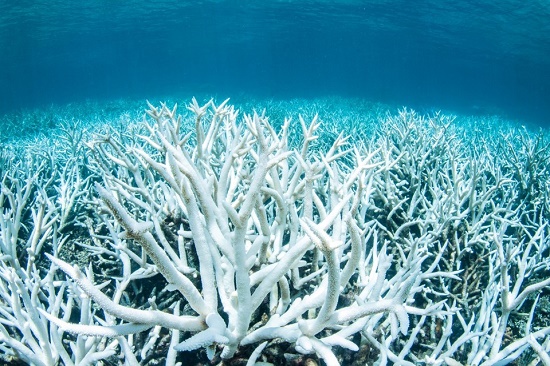
A bleached coral near the Great Barrier Reef on March 16, 2017
At about the same moment that millions of Americans sat staring at their television or laptop or phone—watching the results from the presidential election stream in, seeing state after state called for Donald Trump—Kim Cobb was SCUBA diving near the center of the Pacific Ocean. She did not watch the same trickle of news as other Americans. She surfaced, heard the results, and dove in the water again. She was, after all, attending to devastation.
Cobb is a climate scientist at the Georgia Institute of Technology. On November 8, she was on her most recent of many research trips to Kiritimati Island reef, the largest coral atoll in the world. (Kirimati is pronounced like Christmas.) She first began studying the reef in 1997, during the last big El Niño warming event; she has returned nearly every year since. Last year, she went three times.
“We had been waiting for the big one. And boy… did it happen,” she told me earlier this year. “It really rolled out at an unprecedented magnitude. This particular El Niño event had its maximum temperature loading almost in a bulls-eye almost around Kirimati Island.”
Ruins, Not Reefs: How Climate Change Is Fast-Forwarding Coral Science by Robinson Meyer, The Atlantic Magazine, Apr 11, 2017
Editorial of the Week...
Climate Climax
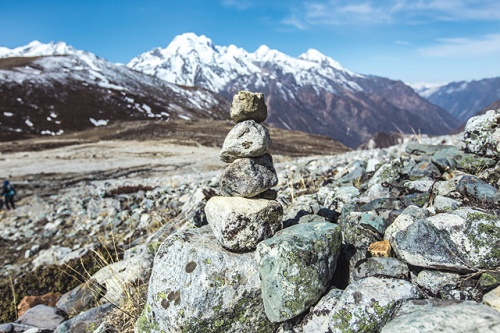
Jitendra Bajracharya
Global measurements of a warming of the earth are more and more frightening. In recent weeks we have learnt that February 2017 was the second-warmest in NASA’s global temperature records that go back 137 years. The only warmer Februrary was last year. The hotspot has been the Arctic, which saw the hottest year on record with temperatures 40 above average in February. Arctic sea ice is seeing a record low winter maximum for three consecutive years.
If all this sounds bad, hear this. The Himalaya is warming much faster than the rest of the planet’s surface. Even if countries meet or exceed their commitments for emission cutbacks, the average global temperature will still rise by 1.4o by 2100, but in the Himalaya, Pamir and Tibetan Plateau, temperatures will go up by 1.8.o The effects will be apocalyptic, and we are already seeing signs of it in Nepal’s glaciers thinning, retreating and losing mass at an alarming rate. Some of these trends were reviewed at an international conference on Understanding Climate Change and Climate Action this week in Kathmandu organised by the Nepal government with Kathmandu-based ICIMOD and the Intergovernmental Panel on Climate Change (IPCC).
Climate Climax, Editorial, Nepali Times, Apr 14, 2017
Toon of the Week...
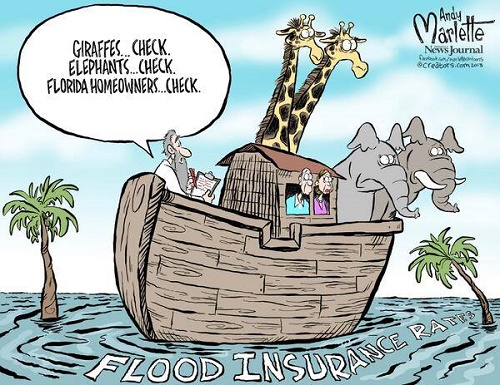
Quote of the Week...
“They have it completely backward,” Gavin Schmidt, director of NASA’s Goddard Institute for Space Studies, told Gizmodo in an email. “No-one uses models blindly—they need to be tested against real-world observations and their predictions have to be evaluated. What Heartland gets wrong is that this has already happened—we have tested GCM predictions and they have not failed but of course they are not perfect either.”
Today’s global climate models are sophisticated simulations of the Earth based on literal millions of data points collected by satellites, meteorological stations, and ocean buoys. As Schmidt notes, these models are constantly validated by comparing their outcomes with what’s happening in nature. Over time, our models have gotten better at reflecting reality, helping Earth scientists to understand the processes shaping that reality.
“Scientists are constantly working to try to improve these models and reduce uncertainty,” climate scientist Patrick Brown of the Carnegie Institution for Science told Gizmodo. “This is all done openly and honestly in the peer-reviewed literature.”
Schmidt added that there are some consequences of climate change that have occurred faster than our models predicted—like the rapid retreat of Arctic sea ice—“so no one thinks the models are perfect.”
“The rest of the Heartland statement is just made up,” Schmidt said. “We include all relevant forcings—including natural ones like volcanoes and solar, and anthropogenic effects that cool the climate like aerosols and irrigation....the notion that we are excluding forcings or feedbacks that run against our ‘mission’ is simply nonsense.”
The Most Insane Claims From the Climate Conspiracy Manual Just Sent to Thousands of Teachers by Maddie Stone, Gizmodo, Apr 11, 2017
Graphic of the Week...
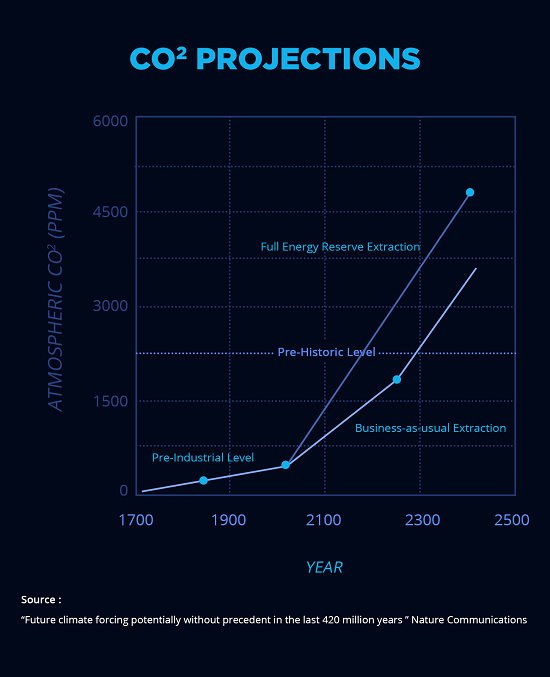
SkS in the News...
[To be added.]
Photo of the Week...
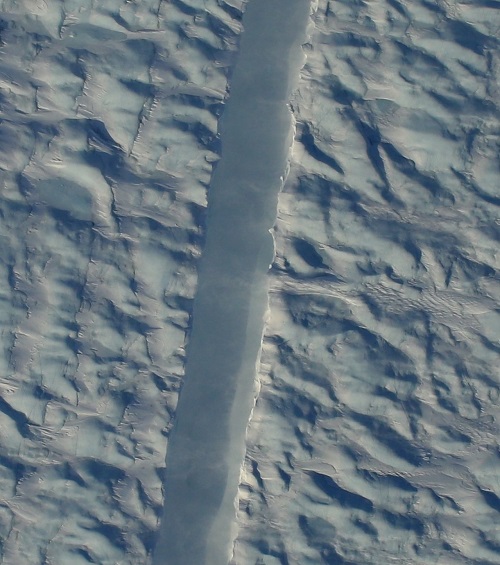
Preliminary DMS image of the new rift in Greenland’s Petermann Glacier, directly beneath the NASA Operation IceBridge aircraft. (Gary Hoffmann/NASA).
NASA just snapped the first photos of a mysterious crack in one of Greenland’s largest glaciers by Chris Mooney, Energy & Environment, Washington Post, Apr 15, 2017
SkS Spotlights...
Mission of the California Ocean Protection Council (OPC)
The OPC will ensure that California maintains healthy, resilient, and productive ocean and coastal ecosystems for the benefit of current and future generations. The OPC is committed to basing its decisions and actions on the best available science, and to promoting the use of science among all entities involved in the management of ocean resources.
Council Guiding Principles and Responsibilities
The Council was created pursuant to the California Ocean Protection Act (COPA), which was signed into law in 2004 by Governor Arnold Schwarzenegger.
The OPC is guided by principles included in COPA:
- Recognizing the interconnectedness of the land and the sea, supporting sustainable uses of the coast, and ensuring the health of ecosystems
- Improving the protection, conservation, restoration, and management of coastal and ocean ecosystems through enhanced scientific understanding, including monitoring and data gathering
- Recognizing the “precautionary principle”: where the possibility of serious harm exists, lack of scientific certainty should not preclude action to prevent the harm
- Identifying the most effective and efficient use of public funds by identifying funding gaps and creating new and innovative processes for achieving success
- Making aesthetic, educational, and recreational uses of the coast and ocean a priority
- Involving the public in all aspects of OPC process through public meetings, workshops, public conferences, and other symposia
The council is tasked with the following responsibilities:
- Coordinate activities of ocean-related state agencies to improve the effectiveness of state efforts to protect ocean resources within existing fiscal limitations
- Establish policies to coordinate the collection and sharing of scientific data related to coast and ocean resources between agencies
- Identify and recommend to the Legislature changes in law
- Identify and recommend changes in federal law and policy to the Governor and Legislature
2012-2017 Priorities
The Ocean Protection Council’s Strategic Plan for 2012 – 2017 proposes action in areas of critical need where the Council’s involvement can yield tangible progress and have the greatest impact. The plan includes goals, objectives and proposed actions that the Council will pursue over the next five years.
Video of the Week...
Michelle Thaller on Science Denial, YouTube, Mar 16, 2017
Reports of Note...
A seven-member working group of the Ocean Protection Council Science Advisory Team has provided the State with a report on the best available sea-level rise science — including recent scientific advances on the role of polar ice loss. The report, entitled Rising Seas in California: An Update on Sea-level Rise Science, includes key findings, an analysis of the contributors that affect how much sea levels will rise along California’s coast, as well as new information on the likelihood of sea level changes based on different greenhouse gas emission scenarios.
This report provides the scientific foundation for updating the State’s Sea-level Rise Guidance Document, which was initially released in 2010 and updated in 2013. Now, the Ocean Protection Council is leading a process to update this statewide guidance document, in collaboration with the California Natural Resources Agency, the Governor’s Office of Planning and Research, the California Energy Commission and the Ocean Science Trust. The guidance document will reflect recent scientific advances and focus on the needs of local governments and state agencies as they incorporate sea-level rise projections into planning, permitting, investment and other decisions.
Public input will be integrated into the final guidance document, which is scheduled for adoption by the California Ocean Protection Council in January 2018. A series of listening sessions to better understand the needs of those who will use the guidance document are occurring on April 17 and 18, 2017. To register, please visit the Updating California’s Sea Level Rise Guidance Document page. A series of public workshops to share the science findings and solicit feedback on how stakeholders will utilize the guidance document will occur in May and June 2017. A draft guidance document will be circulated for formal public comment in the fall of 2017.
The science report is available here.
The press release on the report is available here.
For additional details on the process, please visit the Updating California’s Sea Level Rise Guidance Document page.
Coming Soon on SkS...
[To be added.]
Poster of the Week...
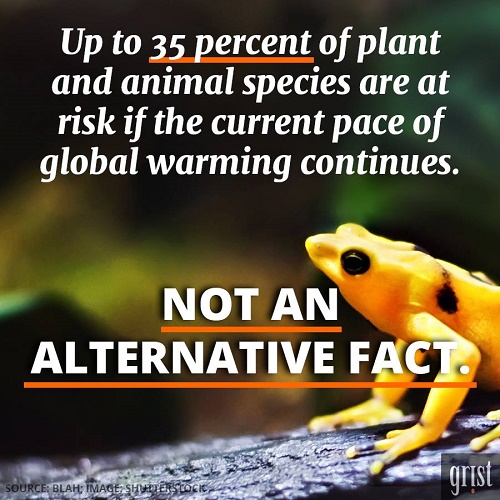
Climate Feedback Reviews...
Climate Feedback asked its network of scientists to review the article, From extreme drought to record rain: Why California's drought-to-deluge cycle is getting worse by Rong-Gong Lin II and Paige St. John, Los Angeles Times, Apr 12, 2017
Four scientists analyzed the article and estimated its overall scientific credibility to be ‘high’.
A majority of reviewers tagged the article as: Accurate Sound reasoning<
Click here to access the entire review.
SkS Week in Review...
- 2017 SkS Weekly Climate Change & Global Warming News Roundup #15 by John Hartz
- New study shows worrisome signs for Greenland ice by John Abraham (Climate Consensus - the 97%, Guardian)
- Scientists can be advocates and maintain scientific credibility by Dana Nuccitelli (The Bulletin of the Atomic Scientists)
- Video: Climate scientists discuss record lows in Arctic and Antarctic sea ice by Roz Pidcock (Carbon Brief)
- From the eMail Bag: A Deep Dive Into Polar Ice Cores by David Kirtley
- Heartland: What's your story? by Sarah
- 2017 SkS Weekly Climate Change & Global Warming Digest #14 by John Hartz
97 Hours of Consensus...
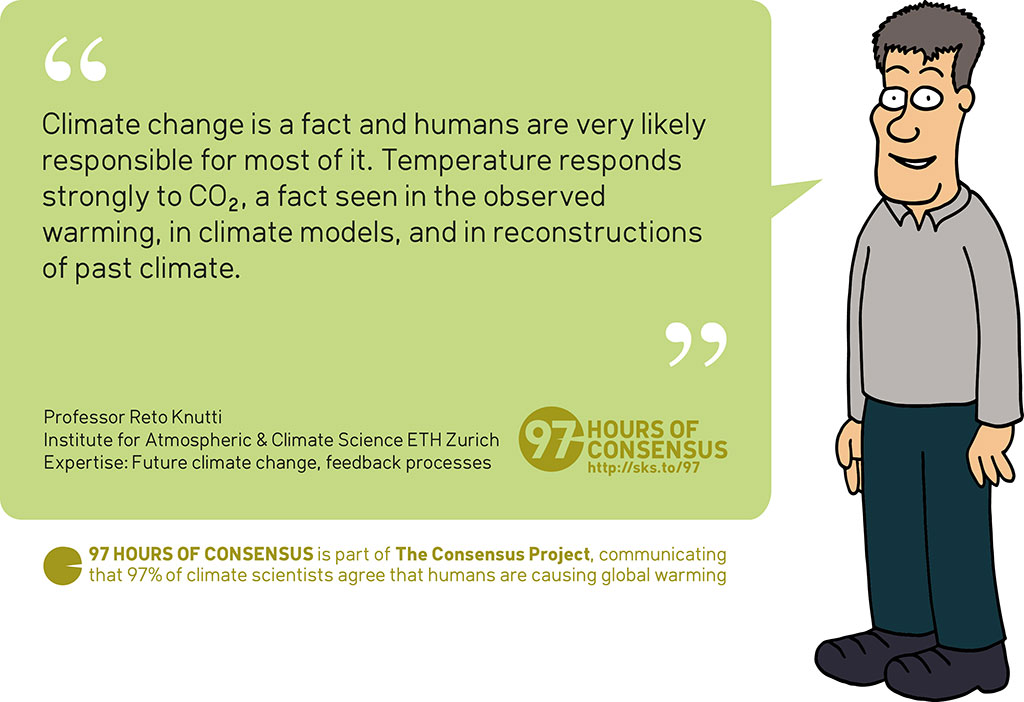
Quote derived with permission from author from:
"Climate change is a fact and humans are very likely responsible for most of it. Long term impacts will mostly be negative. On the positive side: Costs of mitigation, that is to reduce emissions, are smaller than those for prevented damages."































 Arguments
Arguments






























The first article listed in the "stories of the week" discuss the coral bleaching. It should be noted that the GBR along with numerous reefs around indonesia are suffering coral bleaching due to a drop in sea level. Is it possible that other factors unrelated to AGW is causing the bleaching.
http://www.biogeosciences.net/14/817/2017/
[Rob P] Coral die-offs from temporary falls in sea level are a natural phenomenon. The Samoans call it Taimasa - meaning foul-smelling (low) tides. This has to do with the shift in water mass in the Indo-Pacific region associated with ENSO. See the SkS post: What's happening to Tuvalu sea level?
As common sense would indicate, this only affects coral near the surface, especially those exposed at low tide. On the Great Barrier Reef, bleaching extends from the surface to 30-40 depths in some areas and it is from water that is too warm (coral bleaching being a breakdown of the symbiotic relationship between polyp and photosynthetic algae).
Lizard Island on the Great Barrier Reef saw catastrophic levels of bleaching in summer 2016, and yet look at the sea surface height variations for that area. The lowest monthly anomaly in recent times occurred in 2015 - well before bleaching was observed. Moreover, how do such small fluctuations cause bleaching in coral tens of metres deep?
So we can dismiss the sea level aspect as some silly climate change denier contrivance. The National Oceanic and Atmospheric Administration (NOAA) has a whole bunch of information on coral bleaching (Coral Reef Watch) if you're truly interested in understanding this. They even have a coral bleaching outlook, a climate model-based projection which utilizes sea surface temperature anomalies to forecast bleaching events.
Joe: Here's the Abstract of the paper you have provided a link to:
Joe: The answer to your question can be found in:
Why dead coral reefs could mark the beginning of ‘dangerous’ climate change by Chelsea Harvey, Energy & Environment, Washington Post, Apr 12, 2016
Joe: Also see:
The big lie propagated by government and big business is that it is possible to turn things around for the reef without tackling global warming
Australia's politicians have betrayed the Great Barrier Reef and only the people can save it, Opinion by David Ritter, Guardian, Apr 9, 2017
John A) As the article explains, and which you acknowlege, the bleaching and mortaility of the reefs is due to the falling sea level, an event unrelated to and contrary to AGW theory with rising sea levels
B) the Second two articles you cite/link are advocacy / opinion pieces.
Joe @5, you have a few reefs in Indonesia bleaching, due to a local fall in sea level. Most reefs globally, including the GBR, are bleaching due to global warming. You are not fully reading the articles you list, and you are missing the big picture. You did the same thing on the legal persons issue.
www.bom.gov.au/oceanography/oceantemp/GBR_Coral.shtml
Joe,
The sea level fall in Indonesia is unrelated to Global Warming. It is caused by the El Nino cycle. When El Nino appears the trade winds lessen. The water piles up on the Eastern Pacific near Peru. Sea levels in Indonesia fall. During La Nina the trade winds blow harder and sea levels in Indonesia rise (and fall in Peru). This animation clearly shows that sea level in 2016 fell in INdonesia while it rose in Peru.
According to AGW theory, the sea level for the entire globe will rise. Local effects are not relevant. In fact, global sea level did rise in 2015-2016 as this graph shows:
Deniers often confuse local sea level effects with global effects. Local effects are not contradictions to predicted global effects. I note that the article you cite claims that sea levels were at a 12 year low. It was not lower than that because sea level rise caused the base to get higher.
The NY Times is reporting that this year may bring another El Nino, which would be pretty devastating for the GBR.
Joe; I posted the Abstract to the paper you had linked to in hopes that you would acturally read it. If you had, you would see that the researched forcused on a specific location — Bunaken Island (North Sulawesi), Indonesia — with unique sea level rise conditions and for a specific type of coral. For you to suggest that the results of this single study can be extrapolated worldwide is absurd.
The first of the two articles that I linked is not an advocacy article. You actually might learn something by carefully reading it.